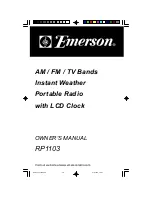
General Alarm Icon
The general alarm icon on the bottom right corner of the LCD will
appear when any weather alarm is activated to show the user that a
set weather condition has been reached. The activated alarm can be
determined by checking the set alarm values against the MIN/MAX
values reached. To deactivate the general weather alarm icon, press
the ALARM key.
Important
When entering the alarm set mode for a specific weather or tempera-
ture condition, the corresponding alarm is automatically enabled (ON)
when the SET key is pressed, regardless of its previous setting and
the alarm value will flash to indicate that it has been activated. Press
the ALARM key to confirm the setting and continue pressing the
ALARM key to toggle through each alarm mode until it returns to the
normal display mode or press the MIN/MAX key at any time to exit the
alarm setting modes.
When a set weather alarm condition has been activated, that particu-
lar alarm will sound and flash for approximately 2 minutes but will
continue to flash until weather conditions have become more steady.
Weather Alarms
The weather alarms are settable for when certain weather conditions
are met according to the users requirements. For example, the user
can set the thresholds for the outdoor temperature to +40° C (high)
and -10° C (low), whilste only enabling the high alarm and disabling
the low alarm (i.e. temperatures <-10° C won’t trigger alarm, but tem-
peratures >+40° C will).
Alarm setting
Minimum
Maximum
Storm threshold
3 hPa
9 hPa
Air Pressure
920.0 hPa
1080.0 hPa
Outdoor Tempera-
ture
-30.0° C
+69.9° C
Indoor Temperature
-9.9° C. No alarm will
sound if the minimum
indoor temperature alarm
is set below -9.9ºC.
+59.9° C
Humidity (all)
20% RH
95% RH
Rainfall 24h
0.0 mm
1000 mm.
Rainfall 1h
0.0 mm
1000 mm
Wind
0.0 m/s
50.0 m/s
Hysteresis
To compensate for fluctuation of the measured data, which may
cause the weather alarm to sound constantly if the measured reading
is close to user set level, a hysteresis function has been implemented
for each weather alarm. For example, if the high temperature alarm is
set to +25° C and the current value moves to +25° C, the alarm will be
activated (if it has been enabled). Now when the temperature drops to
+24.9° C or below and thereafter again increases to 25° C,
the data will be blinking, but no alarm will be activated. It has to drop
to below +24° C (with a pre-set hysteresis of 1° C) so that the alarm
can be produced again. Hysteresis values for the various weather
data types are given in the following table:
Weather data
Hysteresis
Temperature
1° C
Humidity
3% RH
Air pressure
1 hPa
Rainfall 24h
5.0mm
Rainfall 1h
0.5mm
Wind
10 km/h
16. Auto memory for stored values
The base station has a memory back up system, which is used to
memorize user-defined settings for when the batteries are changed or
if a power failure occurs. User defined units are automatically updated
each time these are changed. The base station will memorize the
following user defined units:
•
Time zone
•
12/24h time display mode
•
Unit settings (temperature, pressure, rainfall, wind)
•
Air pressure offset for calculation of relative air pressure
•
Weather picture threshold
•
Storm warning threshold
•
LCD contrast
•
Alarm time
•
Weather Alarm thresholds
•
State of alarms (enabled/disabled)
•
Rainfall total value and reset time/date





































